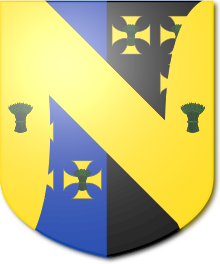There have been two baronetcies created for persons with the surname Bingham, one in the Baronetage of Nova Scotia and one in the Baronetage of the United Kingdom.
The Bingham Baronetcy, of Castlebar in the County of Mayo, was created in the Baronetage of Nova Scotia on 7 June 1634. For more information on this creation, see Earl of Lucan
The Bingham Baronetcy, of West Lea in the Parish of Ranmoor in the City of Sheffield, was created in the Baronetage of the United Kingdom on 12 December 1903 for John Bingham,[1] a leading figure in the Sheffield cutlery industry and pioneer in the electroplating industry. The title became extinct on the death of the second Baronet in 1945.
Bingham baronets, of Castlebar (1634)
[edit]- see Earl of Lucan
Bingham baronets, of West Lea (1903)
[edit]
- Sir John Edward Bingham, 1st Baronet (1839–1915)[2]
- Sir Albert Edward Bingham, 2nd Baronet (1868–1945)[3]
References
[edit]- ^ "No. 27617". The London Gazette. 17 November 1903. p. 7029.
- ^ "Bingham, Sir John Edward". Who's Who. A & C Black. Retrieved 1 April 2023. (Subscription or UK public library membership required.)
- ^ "Bingham, Col Sir Albert (Edward)". Who's Who. A & C Black. Retrieved 1 April 2023. (Subscription or UK public library membership required.)
Well, that’s interesting to know that Psilotum nudum are known as whisk ferns. Psilotum nudum is the commoner species of the two. While the P. flaccidum is a rare species and is found in the tropical islands. Both the species are usually epiphytic in habit and grow upon tree ferns. These species may also be terrestrial and grow in humus or in the crevices of the rocks.
View the detailed Guide of Psilotum nudum: Detailed Study Of Psilotum Nudum (Whisk Fern), Classification, Anatomy, Reproduction